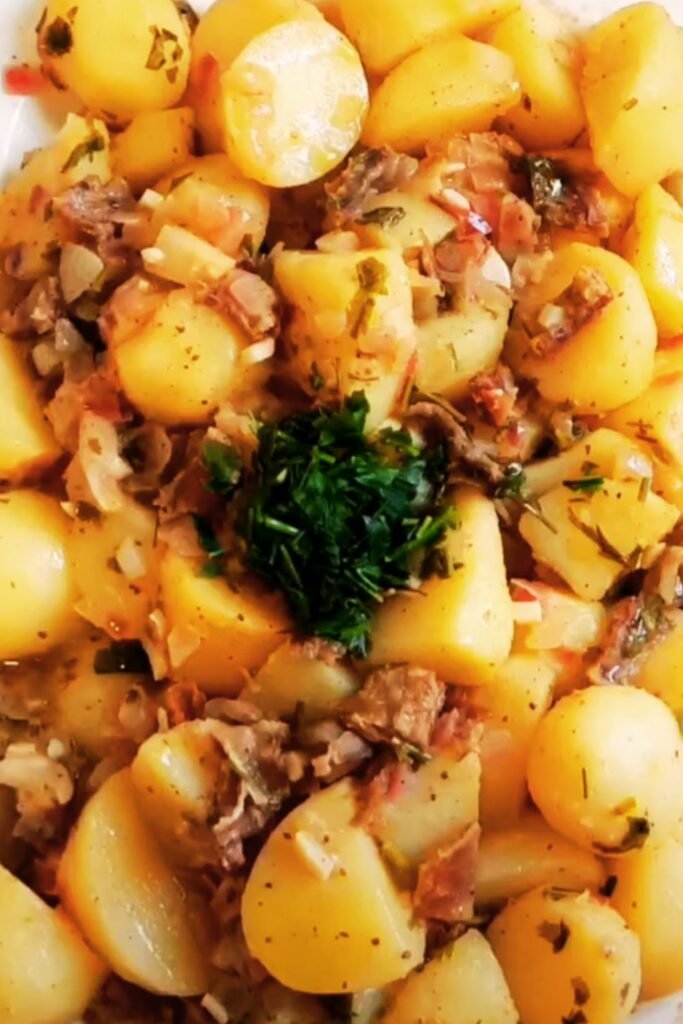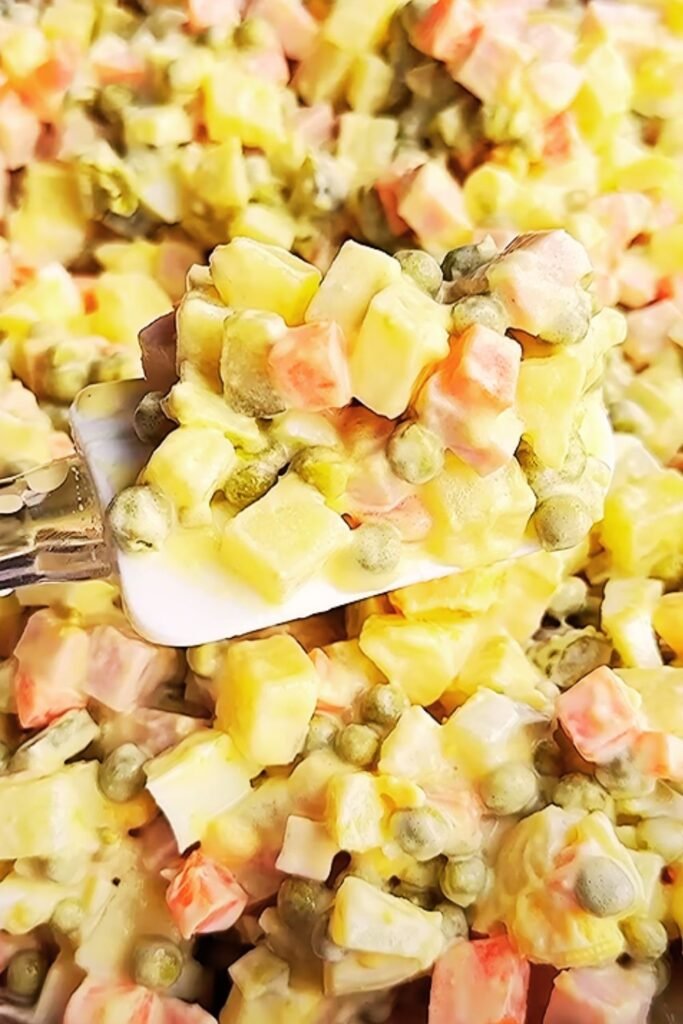There’s something magical about the first time you taste authentic German potato salad. I still remember my initial encounter with this warm, tangy delight during a visit to my friend’s grandmother in Bavaria. The combination of tender potatoes, crispy bacon, and that distinctive vinegar dressing created such a profound impression that I’ve spent years perfecting my own version. Unlike the mayonnaise-laden American potato salads most of us grew up with, German potato salad (or “Kartoffelsalat” as the locals call it) offers a completely different flavor profile that showcases the humble potato in its most glorious form.
What many don’t realize is that German potato salad isn’t just one recipe—it varies dramatically across different regions of Germany. The southern regions, particularly Bavaria, favor the warm, bacon-infused vinegar dressing that has become popular internationally, while northern German versions often incorporate mayonnaise, apples, and pickles. Today, I’m going to share with you my carefully researched and tested recipe for the southern German style—the kind that has stolen the hearts of food enthusiasts worldwide.
The Rich History of German Potato Salad
Before diving into the cooking process, I find it fascinating to understand the cultural context behind this beloved dish. German potato salad dates back to the early 19th century, though potatoes themselves were introduced to Germany in the late 16th century. Initially met with skepticism (and even resistance), potatoes eventually became a staple crop that helped feed the growing population during times of grain shortages.
The regional differences in German potato salad preparation reflect both cultural preferences and practical considerations. In Bavaria and Swabia (southern Germany), the warm vinegar dressing came about partly because it preserved the potatoes better in warmer weather before refrigeration was common. The addition of bacon was a way to incorporate flavorful fat at a time when butter and other dairy products were expensive luxuries for many families.
Northern German styles, with their mayonnaise base, became more prevalent after commercial mayonnaise production began in the late 19th century. These regional variations remind us that even the most “traditional” recipes evolve over time, adapting to changing circumstances and available ingredients.

What Makes German Potato Salad Special?
German potato salad stands apart from other varieties in several key ways:
- Served warm or at room temperature: Unlike American potato salads that are typically chilled, authentic southern German potato salad is traditionally served warm or at room temperature, allowing the potatoes to better absorb the flavorful dressing.
- Vinegar-based dressing: Instead of mayonnaise, the southern German version uses a tangy vinegar dressing that cuts through the richness of the potatoes and bacon.
- Bacon is non-negotiable: The rendered bacon fat forms the foundation of the dressing, imparting a smoky depth that transforms the humble potato.
- Simplicity of ingredients: True German potato salad lets the potatoes shine, using just enough additional ingredients to enhance rather than overwhelm.
Essential Ingredients for Authentic Flavor
Before we begin cooking, let’s discuss the ingredients that make German potato salad truly special:
Potatoes: : Waxy varieties like Yukon Gold or red potatoes are ideal because they hold their shape after cooking and don’t turn mushy. In Germany, varieties like Sieglinde or Heidesand would be traditional choices.
Bacon: : Look for thick-cut, naturally smoked bacon for the best flavor. In Germany, they would use “Speck” which has a more intense smoky flavor than typical American bacon.
Vinegar: : White wine vinegar is traditional, though apple cider vinegar works wonderfully too. The acidity cuts through the richness of the bacon fat and brings brightness to the dish.
Mustard: : German mustard (medium-spicy) adds authentic flavor, but Dijon works as an excellent substitute.
Onions: : Yellow or white onions, finely diced, provide essential aromatic foundation.
Broth: : A small amount of chicken or vegetable broth helps create a more flavorful dressing.
Fresh herbs: : Parsley and chives are traditional, adding color and a fresh counterpoint to the rich dressing.

My Perfect Authentic German Potato Salad Recipe
Now, let’s dive into my meticulously tested recipe that captures the essence of southern German potato salad.
Ingredients:
- 2 pounds (about 900g) waxy potatoes (Yukon Gold or red potatoes)
- 8 ounces (225g) thick-cut bacon, diced
- 1 medium yellow onion, finely diced
- ¼ cup white wine vinegar
- 2 tablespoons German mustard or Dijon mustard
- ½ cup chicken or vegetable broth, warm
- 1 teaspoon sugar
- ½ teaspoon freshly ground black pepper
- Salt to taste (be careful as bacon is already salty)
- 3 tablespoons fresh parsley, chopped
- 2 tablespoons fresh chives, finely sliced
- Optional: 1 tablespoon caraway seeds
Step-by-Step Instructions:
- Prepare the potatoes: Place whole, unpeeled potatoes in a large pot and cover with cold water. Add 1 tablespoon of salt to the water. Bring to a boil, then reduce to a simmer. Cook until the potatoes are just tender when pierced with a knife, about 15-20 minutes depending on size. Be careful not to overcook them!
- While potatoes cook, prepare the dressing: In a large skillet over medium heat, cook the diced bacon until crispy, about 8-10 minutes. Using a slotted spoon, transfer the bacon to a paper towel-lined plate, leaving the rendered fat in the pan.
- Create the flavor base: Add the diced onions to the bacon fat and cook until translucent and slightly golden, about 5-7 minutes. Don’t rush this step – properly cooked onions provide a wonderful sweetness that balances the acidity.
- Make the dressing: Reduce heat to low and add the vinegar, mustard, warm broth, sugar, and black pepper to the skillet with the onions. Whisk to combine, scraping up any browned bits from the bottom of the pan. Let simmer for 2-3 minutes to meld the flavors.
- Prepare the potatoes for dressing: When the potatoes are done, drain them thoroughly and let them cool just enough to handle. While still warm, peel them if desired (traditional German recipes often leave the peels on for rustic texture and added nutrition). Slice the potatoes into ¼-inch rounds or bite-sized chunks.
- Combine everything: In a large bowl, gently toss the warm sliced potatoes with the hot dressing. Add the reserved bacon, parsley, chives, and caraway seeds (if using). Fold everything together carefully to avoid breaking the potatoes.
- Let the flavors develop: Allow the salad to rest for at least 15 minutes before serving. This gives the potatoes time to absorb the dressing. The salad can be served warm or at room temperature.
- Final seasoning: Just before serving, taste and adjust seasoning if needed with additional salt, pepper, or a splash more vinegar for brightness.

Regional Variations Worth Exploring
I’ve spent considerable time exploring the different regional approaches to German potato salad. Here are some fascinating variations you might want to try:
Northern German Style (Nordeutsche Kartoffelsalat):
- Incorporates mayonnaise instead of vinegar dressing
- Often includes apples, pickles, and sometimes herring
- Always served cold
- Frequently contains hard-boiled eggs
Swabian Style:
- Uses beef broth instead of chicken broth
- Often includes finely sliced radishes
- Features a more pronounced mustard flavor
- Sometimes includes cucumber
Berlin Style:
- Combines elements of both northern and southern styles
- Often contains both mayonnaise and vinegar
- Includes pickles and occasionally beets
- Frequently seasoned with dill
The table below highlights the key differences between these regional variations:
| Region | Base | Served | Unique Ingredients | Texture |
|---|---|---|---|---|
| Bavaria (South) | Vinegar & bacon fat | Warm | Bacon, mustard, sometimes caraway | Firm potato chunks |
| Northern Germany | Mayonnaise | Cold | Apples, pickles, eggs | Creamier, often with smaller potato pieces |
| Swabia | Beef broth & vinegar | Warm | Radishes, enhanced mustard | Medium-firm slices |
| Berlin | Mayo-vinegar hybrid | Room temp | Pickles, beets, dill | Varied textures |
Critical Techniques for Perfect Results
Through years of making this dish, I’ve identified several techniques that dramatically improve the final result:
- Never overcook the potatoes: They should be tender but still hold their shape. Test frequently with a knife toward the end of cooking time.
- Dress potatoes while they’re warm: This is absolutely crucial! Warm potatoes absorb the dressing much better than cold ones, resulting in more flavorful salad.
- Layer the flavors: Building the dressing in the same pan used for cooking the bacon utilizes all those delicious browned bits (known as “fond” in culinary terms).
- Give it time to rest: Like many dishes with multiple components, German potato salad improves after the ingredients have had time to mingle.
- Balance is key: The perfect German potato salad has a harmonious balance of acidic (vinegar), savory (bacon), sweet (onions), and aromatic (herbs) elements.
Make-Ahead and Storage Tips
One of the wonderful things about German potato salad is that it often tastes even better the next day! Here’s how to handle making it ahead and storing leftovers:
- Make-ahead options: You can prepare the entire salad up to 24 hours in advance. Store it in the refrigerator, then bring to room temperature before serving, or gently reheat in a low oven or microwave if you prefer it warm.
- Reheating tips: When reheating, add a splash of broth or water to refresh the dressing if it seems dry. Cover the salad while reheating to help retain moisture.
- Storage: Leftovers will keep in an airtight container in the refrigerator for up to 3 days.
- Safety note: Because this salad contains bacon and no preservatives, don’t leave it at room temperature for more than 2 hours, especially in warm weather.
Perfect Serving Suggestions
Traditional German meals typically include potato salad as a side dish. Here are some authentic pairings that complement it beautifully:
- Schnitzel: The crispy, breaded cutlet provides a wonderful textural contrast to the tender potatoes.
- Bratwurst or other German sausages: The classic combination found at beer gardens and festivals throughout Germany.
- Roast pork (Schweinebraten): The hearty flavors of roasted pork work beautifully with the tangy potato salad.
- Roast chicken: The simplicity of herb-roasted chicken allows the flavors of the potato salad to shine.
- German meatballs (Frikadellen): These seasoned meat patties are often served with potato salad in casual home cooking.
Nutritional Benefits and Considerations
While potato salad isn’t usually considered a health food, this version offers some nutritional advantages over mayonnaise-based varieties:
- Lower in fat: Without mayonnaise, this version contains significantly less fat than traditional American potato salad.
- Beneficial nutrients: Potatoes are a good source of vitamin C, potassium, and vitamin B6.
- Probiotics potential: The vinegar in the dressing can help support digestive health.
- Customization options: For a lighter version, you can reduce the amount of bacon or substitute turkey bacon, though this will affect the authentic flavor profile.
Troubleshooting Common Issues
Even experienced cooks sometimes encounter challenges with German potato salad. Here are solutions to the most common problems:
- Potatoes fall apart: You likely overcooked them or used a starchy variety instead of waxy potatoes. Next time, test frequently with a knife and stop cooking as soon as they’re just tender.
- Dressing is too acidic: Balance with a touch more sugar, or add a little more broth to dilute the vinegar.
- Not enough flavor: Ensure you’re using enough salt (remembering that it should be added to the cooking water too). Also, don’t rush cooking the onions—properly caramelized onions add considerable depth.
- Too dry after storing: The potatoes continue to absorb liquid over time. When reheating leftovers, add a splash of broth or water and a drizzle of olive oil to refresh the texture.
Frequently Asked Questions
Q: Can I make German potato salad vegetarian?
While bacon is a defining element of southern German potato salad, you can create a vegetarian version by substituting smoked paprika and olive oil for the bacon and its rendered fat. You’ll miss some of the depth, but it will still be delicious. Adding a bit of vegetable “Better Than Bouillon” or mushroom powder can help replace some of the umami flavor from the bacon.
Q: How far in advance can I make German potato salad?
You can make it up to 24 hours ahead of time. In fact, many people (myself included) think it tastes even better the next day after the flavors have had time to meld. Just be sure to store it properly in the refrigerator and bring it back to room temperature before serving.
Q: My family prefers cold potato salad. Will this recipe work cold?
While authentic southern German potato salad is traditionally served warm or at room temperature, this recipe can certainly be enjoyed cold. Just be aware that cold temperatures dull flavors slightly, so you might want to add a little extra vinegar and seasonings if you plan to serve it chilled.
Q: Can I use a different type of vinegar?
Yes! While white wine vinegar is traditional, apple cider vinegar makes an excellent substitute. Red wine vinegar works too, though it will give the salad a slightly different color. I would avoid balsamic vinegar as its sweetness and strong flavor would overpower the other components.
Q: What’s the best way to cook the potatoes?
Starting the potatoes in cold water helps them cook more evenly. Some cooks prefer steaming potatoes for salad, which can reduce water absorption and result in more flavorful potatoes. Either method works well—just be careful not to overcook them.
My Personal Connection to German Potato Salad
I first encountered authentic German potato salad during a memorable trip through Bavaria. The small family-run inn where I stayed served it alongside a perfectly crisp schnitzel, and I was immediately struck by how different it was from the American potato salads I’d grown up with. The innkeeper was kind enough to share her basic approach, which I’ve refined over years of experimentation.
What I love most about this dish is how it showcases the beautiful simplicity of German cooking—taking humble ingredients and transforming them into something extraordinary through thoughtful preparation and balanced flavors. Each time I make this potato salad, it transports me back to that charming Bavarian village and reminds me of how food connects us across cultures and generations.
There’s something deeply satisfying about preserving and sharing traditional recipes like this one, especially in our fast-paced world of convenience foods. Taking the time to properly cook the onions, to dress the potatoes while they’re still warm, to allow the flavors to develop—these small acts of culinary mindfulness result in a dish that’s far greater than the sum of its parts.
I hope this recipe brings as much joy to your table as it has to mine over the years. Whether you’re serving it at a summer barbecue or alongside a hearty winter meal, German potato salad offers a taste of Old World tradition that never fails to impress.
Q&A Section
Q: Is German potato salad always served warm?
The southern German style (particularly Bavarian) is traditionally served warm or at room temperature, while northern German varieties are typically served cold. The warm version allows the potatoes to better absorb the flavorful dressing, creating a more cohesive dish.
Q: How is German potato salad different from American potato salad?
German potato salad (specifically the southern style) differs from American versions primarily in its dressing—using vinegar instead of mayonnaise—and in being served warm rather than chilled. It also typically includes bacon as a key flavor component, while American versions often incorporate eggs, celery, and pickles.
Q: Do Germans actually eat this potato salad or is it an American creation?
Yes, Germans absolutely eat potato salad, and it’s a beloved traditional dish throughout the country! However, what Americans often call “German potato salad” specifically refers to the southern German style. In Germany itself, you’ll find numerous regional variations, all considered authentic within their respective areas.
Q: Can I prepare this salad ahead of time for a party?
Absolutely! In fact, making it a day ahead can improve the flavor as the ingredients have more time to meld. Store it in the refrigerator, then bring to room temperature before serving, or gently reheat if you prefer it warm. You might need to refresh it with a splash of broth and adjust the seasonings before serving.
Q: What type of potatoes work best for German potato salad?
Waxy or medium-starch potatoes work best because they hold their shape after cooking. Good options include Yukon Gold, red potatoes, or fingerlings. Avoid high-starch potatoes like Russets, which tend to fall apart and create a mushy texture in the salad.